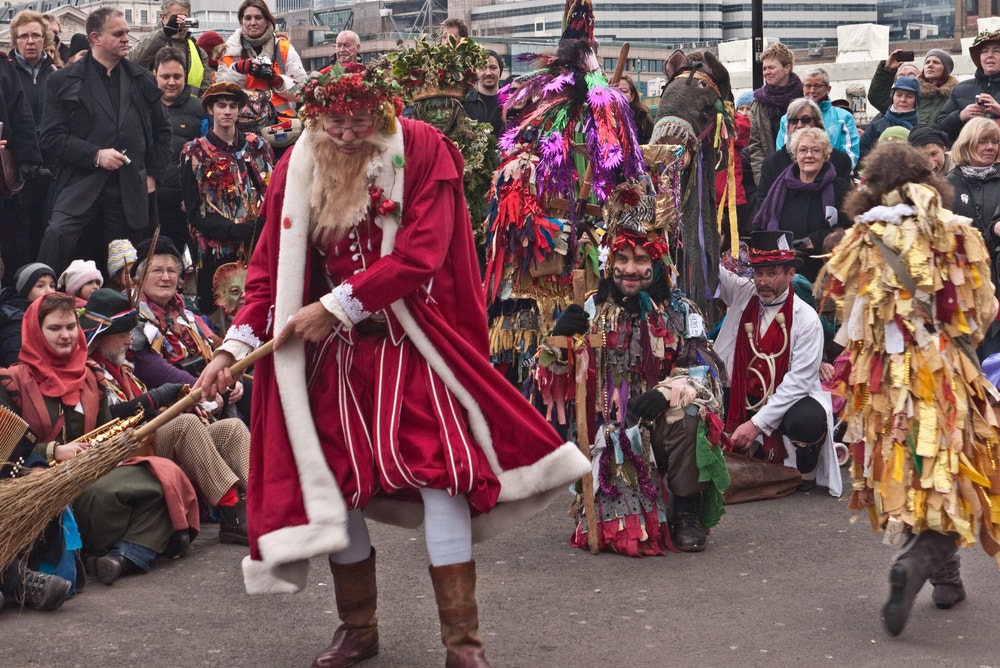The 12 Days of Christmas Song is … Weird
Simply put, I adore Christmas. The food, the lights, the songs, the stories—and hey, let’s be honest, the presents—it’s a difficult holiday not to love. But no matter how much you might adore this holiday, you’ll surely agree that the “12 Days of Christmas” song is … well … it’s pretty weird.
Without any historical context, the gifts on offer from the singer’s “true love” seem utterly flippin’ nuts. The gifts are comprised entirely of birds, trees, and people doing various forms of labor. Oh, and then five gold rings, since one or two aren't going to cut it. We can’t forget those, given they’re probably the only one of the gifts in the song everyone always universally remembers ... or could ever reasonably want.
Just imagine someone saying “Merry Christmas, here are seven swans. Oh, by the way, they’re swimming in that icy-cold half frozen river over there. Enjoy chasing and capturing them!” You’d feel pretty insulted, right? That’s the sort of gift you give someone you don’t like.
As Tent and Table rolls out another big Christmas sale this year, I've found myself thinking about this weird song. Just how strange are those “gifts” mentioned in the song, really? Is there some hidden meaning behind the lyrics? And what's with all the birds? Do partridges really hang out in pear trees?
Let’s find out! Here are 12 facts you probably didn't know about the 12 Days of Christmas. And it turns out there’s actually some interesting history behind this famous song, too.
1. The 12 Days of Christmas Don’t Start When You Think They Do
Most people think the 12 Days of Christmas begin on December 14th and end on December 25th. They actually begin on Christmas Day and end on January 5th. They mark the time between the birth of Jesus Christ and the arrival of the Three Wise Men who visit him bearing gifts.
2. The 12 Days of Christmas Were Celebrated for a Very Long Time
Starting sometime prior to the Middle Ages, the 12 days of Christmas were celebrated throughout much of Europe, a tradition that faded over time. Each of the 12 days were marked with a feast meant to honor various saints and other figures from the Christian faith. Some denominations of Christianity still observe these holidays and celebrate with feasts. The biggest (and perhaps craziest) of these celebrations would happen on January 5th. The “Twelfth Night” celebrations involved big parties with cake and games.

3. The Song’s Animal Theme Relates to Those Celebrations, Too
Perhaps the biggest mystery of the song relates to all of the animals, mostly birds, listed in it. And no, the answer isn’t as simple as the singer’s true love being an ornithophile.
All of those feasts we just mentioned that took place throughout the 12 Days of Christmas? Most of the animals mentioned in the song were actually destined for the dinner table. The singer’s true love is presenting them with food, rather than living birds.
Some older versions of the song referenced acts we’d label as animal cruelty in modern times. Older iterations of the song mention bears and badgers “baiting,” which refers to blood sport games where these creatures would be thrown into a ring with angry dogs to fight to the death for the amusement of onlookers. According to The Smithsonian, some of the entertainment offered up during the 12 Days of Christmas likely involved these sorts of brutal showings.
4. A Partridge in … Another Partridge?
 Speaking of animals, it turns out the famed “partridge in a pear tree” line didn’t have anything to do with a pear tree whatsoever at first. In fact, partridges don’t even like pears, nor do they spend much time in pear trees. So what the heck is this verse even about? Let’s explain.
Speaking of animals, it turns out the famed “partridge in a pear tree” line didn’t have anything to do with a pear tree whatsoever at first. In fact, partridges don’t even like pears, nor do they spend much time in pear trees. So what the heck is this verse even about? Let’s explain.
Many historians believe the 12 Days of Christmas started out as a French poem, which made its way over to Newcastle, England in the 18th century (more on that in a bit). Originally, the gift was merely mentioned as just “one partridge,” which in French is spelled “une perdrix” and is pronounced “oon-eh pear-dree.”
English children sang this line as “a partridge, une perdrix” in an effort to keep the French saying in place. And when you hear that phrase out loud—”une perdrix”—it sounds like you’re actually saying “in a pear tree.”
Pass that half-English, half-French line around a few times, and the telephone game effect changes it into “a partridge in a pear tree.”
5. So … Many … Animals!
In all of the most popular iterations of the song, more than half of the verses refer to birds of some kind. And in older versions, each of the 12 verses in the song have, at one point or another, referenced animals, either as gifts themselves or as a part of those gifts. And now to really blow your mind …
6. The “Five Gold Rings” Probably Reference—Wait for It!—Another Bird
The one and only material object in the 12 Days of Christmas song? It turns out it’s probably just another bird. Many historians believe the “Five Gold Rings” line isn’t a reference to medieval bling, but medieval birds. A ring-necked pheasant, to be precise. These birds have feathers with a coppery or golden appearance covering most of their bodies. So we can probably check another box in the birds category here, too.
7. The 12 Days of Christmas Migrated to England
The true origins of the song aren’t really known, but historians are pretty confident it’s French. There’s strong evidence the song ended up in Newcastle, England sometime in the early 18th century. Its first ever printing happened in 1780, in a children’s book called “Mirth Without Mischief.”
8. It Wasn’t Originally a Song, but a Game
The 12 Days of Christmas didn’t start out its life as a song, either. Most historians believe it was originally stated more as a poem than a song, and was used in a “memory and forfeits” game. The person reciting the song had to try and remember what each of the gifts were, while their opponent would keep track.
If the singer failed to recite the exact lyrics verbatim, they had to offer their opponent a “forfeit,” which usually involved some small wager, a gift, a token of affection, or even a kiss. This was a popular game for children to play during Twelfth Night festivities.
The 12 Days of Christmas didn’t really become a song until 1909, when English Composer Frederic Austin put the children’s poem to music. The song we know today mostly stems from Austin’s rendition.
9. “Gold” or “Golden” Rings? It Doesn’t Really Matter
Some people like to complain when you sing the fifth verse as “five golden rings,” snootily informing you the song “traditionally” references “five gold rings.” These people are right … and they're also wrong. Both date back centuries and one could easily argue that both versions would be considered traditional or "correct."
10. The 12 Days of Christmas: Mythbusters Edition
A widespread theory found on the Internet claims the 12 Days of Christmas song is deeply coded with hidden Christian symbolism. The story claims persecuted Christians created the song in an effort to pass down Christian messages. But historians and fact checkers have thoroughly debunked this story as a myth. It’s definitely a Christian song referencing the biggest of all the Christian holidays, but it has absolutely nothing to do with persecution or hidden, secret messages.
11. The Closest We Get to a Real Hidden Message …
If you add up every single gift in the song, each and every time it’s mentioned, you end up with 364 gifts in all … one for each day of the year, excluding Christmas. That’s not likely a secret hidden missive so much as an interesting, happy accident. But hey, it’s pretty neat all the same!

12. And Speaking of Adding Up those Gifts in the 12 Days of Christmas …
In 1984, PNC Bank created what they call “The PNC Christmas Price Index,” which analyzes market prices and compiles them into a full and comprehensive breakdown of how much it would cost to acquire each and every one of the gifts mentioned in the song. And they’ve been crunching these numbers every holiday season since.
PNC Bank uses some creative liberties—for instance, “Ladies Dancing” is priced at the cost of hiring a troupe of professional dancers—blended with standard going rates on real labor and materials.
So how much are all of these items really worth? According to PNC Bank’s analysis, the cost of each of the gifts in the song cumulatively in 2019 would be exactly $38,993.59. The “true cost,” which they define as the cost of all the items added up across each of the song’s twelve versus, stands at $170,298.03.
Are ‘The 12 Days of Christmas’ a Little Less Strange Now?
Now that we understand the full history behind the 12 Days of Christmas, the song is considerably less bizarre than it seemed prior, right? Just knowing the song references giving food as gifts rather than handing someone a full on aviary reduces the song’s overall peculiarity by what, a thousand percent?
The 12 Days of Christmas is a classic staple of the holiday season, one that will still be caroled by grade school choirs many generations from now. And let’s be honest … you found a lot of this stuff about the history of The 12 Days of Christmas to be more interesting than you thought it would be, right?
Some of you rental operators out there might be wondering why on Earth we'd devote an entire blog to this song. We don't even mention party tents or folding tables and chairs or bounce houses even once (well, until this sentence). The short answer? We just thought this was interesting stuff. And if you've been following TNT for a while, you probably know that we reference this song a lot in our Christmas sales and on social media. Want to get back to business? Go check out that Christmas sale and find great deals on stuff!




